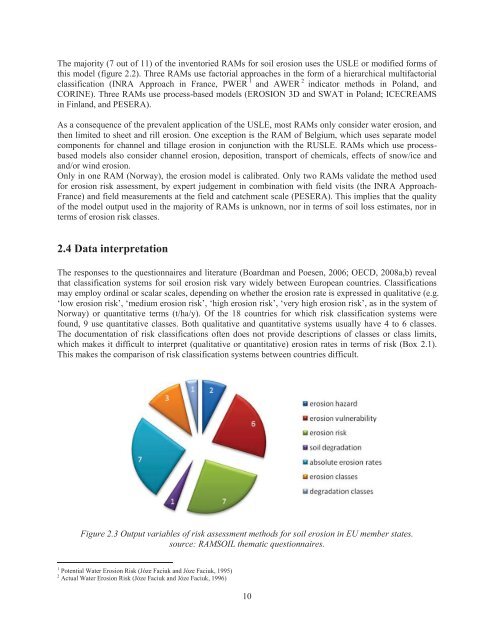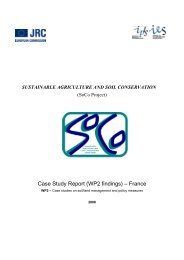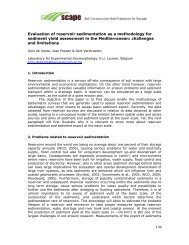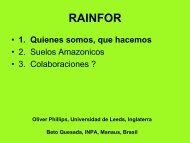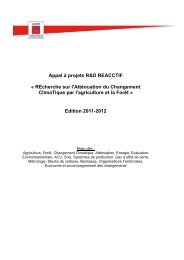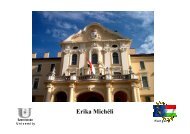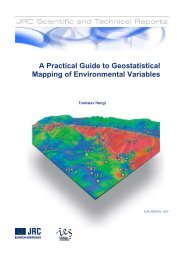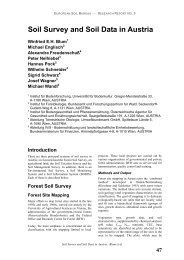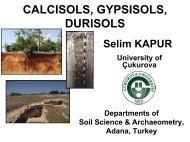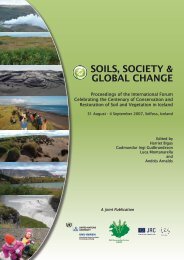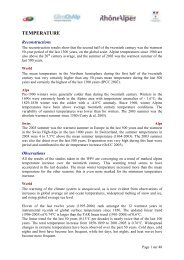Risk Assessment Methodologies of Soil Threats in Europe
Risk Assessment Methodologies of Soil Threats in Europe
Risk Assessment Methodologies of Soil Threats in Europe
You also want an ePaper? Increase the reach of your titles
YUMPU automatically turns print PDFs into web optimized ePapers that Google loves.
The majority (7 out <strong>of</strong> 11) <strong>of</strong> the <strong>in</strong>ventoried RAMs for soil erosion uses the USLE or modified forms <strong>of</strong><br />
this model (figure 2.2). Three RAMs use factorial approaches <strong>in</strong> the form <strong>of</strong> a hierarchical multifactorial<br />
classification (INRA Approach <strong>in</strong> France, PWER 1 and AWER 2 <strong>in</strong>dicator methods <strong>in</strong> Poland, and<br />
CORINE). Three RAMs use process-based models (EROSION 3D and SWAT <strong>in</strong> Poland; ICECREAMS<br />
<strong>in</strong> F<strong>in</strong>land, and PESERA).<br />
As a consequence <strong>of</strong> the prevalent application <strong>of</strong> the USLE, most RAMs only consider water erosion, and<br />
then limited to sheet and rill erosion. One exception is the RAM <strong>of</strong> Belgium, which uses separate model<br />
components for channel and tillage erosion <strong>in</strong> conjunction with the RUSLE. RAMs which use processbased<br />
models also consider channel erosion, deposition, transport <strong>of</strong> chemicals, effects <strong>of</strong> snow/ice and<br />
and/or w<strong>in</strong>d erosion.<br />
Only <strong>in</strong> one RAM (Norway), the erosion model is calibrated. Only two RAMs validate the method used<br />
for erosion risk assessment, by expert judgement <strong>in</strong> comb<strong>in</strong>ation with field visits (the INRA Approach-<br />
France) and field measurements at the field and catchment scale (PESERA). This implies that the quality<br />
<strong>of</strong> the model output used <strong>in</strong> the majority <strong>of</strong> RAMs is unknown, nor <strong>in</strong> terms <strong>of</strong> soil loss estimates, nor <strong>in</strong><br />
terms <strong>of</strong> erosion risk classes.<br />
2.4 Data <strong>in</strong>terpretation<br />
The responses to the questionnaires and literature (Boardman and Poesen, 2006; OECD, 2008a,b) reveal<br />
that classification systems for soil erosion risk vary widely between <strong>Europe</strong>an countries. Classifications<br />
may employ ord<strong>in</strong>al or scalar scales, depend<strong>in</strong>g on whether the erosion rate is expressed <strong>in</strong> qualitative (e.g.<br />
‘low erosion risk’, ‘medium erosion risk’, ‘high erosion risk’, ‘very high erosion risk’, as <strong>in</strong> the system <strong>of</strong><br />
Norway) or quantitative terms (t/ha/y). Of the 18 countries for which risk classification systems were<br />
found, 9 use quantitative classes. Both qualitative and quantitative systems usually have 4 to 6 classes.<br />
The documentation <strong>of</strong> risk classifications <strong>of</strong>ten does not provide descriptions <strong>of</strong> classes or class limits,<br />
which makes it difficult to <strong>in</strong>terpret (qualitative or quantitative) erosion rates <strong>in</strong> terms <strong>of</strong> risk (Box 2.1).<br />
This makes the comparison <strong>of</strong> risk classification systems between countries difficult.<br />
Figure 2.3 Output variables <strong>of</strong> risk assessment methods for soil erosion <strong>in</strong> EU member states.<br />
source: RAMSOIL thematic questionnaires.<br />
1 Potential Water Erosion <strong>Risk</strong> (Józe Faciuk and Józe Faciuk, 1995)<br />
2 Actual Water Erosion <strong>Risk</strong> (Józe Faciuk and Józe Faciuk, 1996)<br />
10


